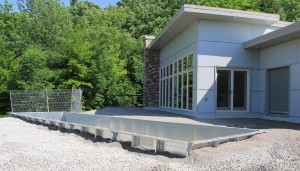
John Bleasby
From pilot to contractor (24): Choosing a cool pool
The choice between a steel-walled vinyl swimming pool, a concrete one or a fibreglass unit, was easy to make for John Bleasby. Steel-walled vinyl was a clear winner.
The steel walls of the Bleasbys’ pool are reinforced at their base by 18-inches of poured concrete, then backfilled with high quality gravel substrate.
Exchanging lakefront for country acreage required some soul-searching on our part. Although no one ever feels sorry for someone with a house by a lake, there are in fact lack-of-privacy issues, not to mention high taxes, that accompany waterfront homes near any city or town. But the convenience of a quick dip on a hot day was something we could not sacrifice. So a pool became part of our plan.
As explained before, our hillside main floor pool/patio level offers some serious structural challenges. No matter how much machine compacting is done or settling time is allowed, a risk of some soil shifting remains, particularly in a cold climate like south-central Ontario. Backfilling and topping with quality compactible gravel is compulsory.
This in turn impacted our choice of pool construction: steel-walled vinyl, fibreglass, or concrete. By process of elimination, we selected steel-walled vinyl. Here’s why:
Given our site location and budget, concrete was dismissed quickly. Concrete is not only many times the cost of the other systems, but there are serious problems that are difficult to resolve, such as cracking.
Fibreglass offers certain structural advantages and straight forward installation. However, I could not source in Canada the very simple pool size and shape we wanted; a 40’ by 10’ lap pool with water depth of 4 feet. We’re well past the age for diving boards and waterslides; we just want to exercise. Curvy shapes and deep water depths weren’t priorities. Plus, pool shells come in limited colours.
My concern with steel-walled pools with vinyl liners was not the strength of construction. In fact, they are as strong and as stable as the others. It was the vinyl liner itself. Research seemed to indicate that they rip, degrade with UV exposure, or otherwise deteriorate quickly due to chemicals. Pool liner life was estimated to be 5 years, 10 year, maybe 12 years, depending on the information source.
“Not so,” says Terry Knight of Sunshine Pools. Given the smaller size of my proposed pool and the heavy gauge of vinyls used by top manufacturers, Terry assured me that the liner’s useful life was potentially longer than mine! He’s installed and serviced countless pools in this region and observes that improper chemical balances in the water result in the early demise of a vinyl liner more than any other factor. “Read the instructions on the bottle,” he says.
The adaptability of a steel-walled vinyl pool to our changeable climate, economy, variety of liner patterns, and almost limitless shape and size possibilities made this my obvious choice. I look at the construction of the steel walls now underway with their concrete reinforcing and the sculpted vermiculite/concrete floor, and I can see why steel-walled vinyl pools remain the most popular choice of all.


Leave a Reply